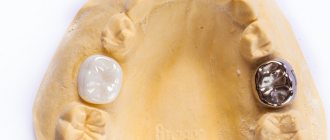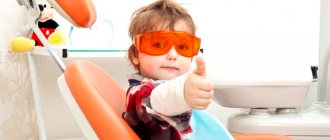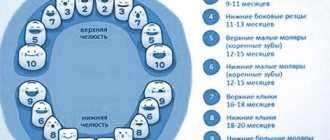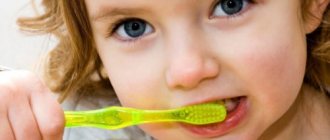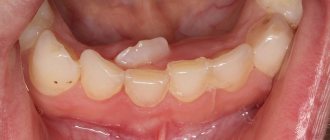Baby teeth are very important. We have more than once encountered the reaction of parents in a situation where they bring a child with advanced multiple caries. “How much will it cost to cure eight teeth? No, I won’t, because of compulsory medical insurance they will snatch everything for free.” Unfortunately, parents often do not understand that the loss (or loss) of primary teeth is very critical for the formation of a healthy orthognathic bite.
The chain is quite simple:
- The tooth was removed much earlier than the date of its replacement.
- The adjacent teeth turned and tilted to close the defect.
- The growth of the jaws has slowed down or stopped, as they depend on the chewing load.
- The permanent teeth erupted with defects, as the rudiments were damaged by infection.
- In adolescence, we have complex dental anomalies and very, very expensive orthodontic treatment that lasts for years in order to somehow correct this.
Therefore, today I will tell you what you need to do for free with your child at the start, so as not to spend a lot of money and effort on treatment in the future.
How many teeth does a child have?
teeth in a six and a half year old child.
The first chewing permanent teeth have appeared, but the incisors have not yet erupted. If you do not take supernumerary “bonus” teeth, then a person usually has 28–32 permanent teeth and 20 milk teeth. That is, at the moment shortly before the first change of teeth, a child has up to 52 teeth simultaneously in his jaw. I am still surprised when I see X-rays of the jaws of children aged six to nine years old. Sometimes there is a feeling that there are more teeth there than the jaw itself.
The skull in children has a peculiar shape. It is difficult to pass through the birth canal, the pelvis is narrow, and the head is rather large. You need to save on something so as not to get stuck along the way. You can't really save money on brains. They should immediately be sufficiently developed. As a result, evolution came to the mechanism of movable skull bones, which run over each other like tiles. The real savings in head size come from the front of the skull. Children have very small upper and lower jaws, and their teeth are in the form of tiny rudiments. This allows us to be born with minimal problems, but it also means that we need to grow these same jaws over the next few years of life. And this is where the difficulties begin.
Jaw width growth is regulated primarily by load. And this is where parents often make two important mistakes.
At first, when refusing breastfeeding, they often choose a nipple with a large hole to make it easier for the child to eat. And children are very lazy. If they understand that they can no longer pretend to be a vacuum installation, trying to eat everything that was synthesized for them in the breast, then they quickly begin to spit at the sight of a natural nipple and demand a bottle. The effort required for sucking is very great. It’s not for nothing that children have such huge cheeks because of Bisha’s fatty lumps. There is a theory that they need hamster cheeks so that the tissue can withstand the sucking process without consequences. And some brown fat to warm your head.
The second mistake occurs when the child’s first teeth appear. At this age they are very curious and try to try everything they see. Especially if one of the parents eats it in front of them. At a friend's house, a child was cracking a hefty piece of shish kebab, about 100 grams long, when the adults turned their backs. Moreover, so far there were only upper teeth. This did not bother him, and he simply removed the shavings from it, like a lathe. In general, this is a normal process. Problems begin when a child chokes on a piece of apple or carrot a couple of times. Nervous parents immediately return to pureed and crushed foods. And children are lazy, as you remember. Chewing is difficult, you have to strain. Very quickly, a one-year-old child can begin to depict his painful death from a terrible piece of pear and demand homogeneous cereals and purees.
Why is it important to treat baby teeth?
Now that it is clear that the structure of baby teeth is very similar to permanent teeth, the question “To treat them or not to treat them” should not arise for parents at all. Advanced caries often leads to destruction and damage to the pulp. Then the roots become involved in the pathological process. Removing dental nerves is not a pleasant procedure. It is important to prevent its occurrence.
Moreover, refusal of dental treatment can result in a number of other problems. This means:
- Incorrect bite formation. If, due to the destruction of the crown, the doctor has to remove it ahead of time, voids appear in the row, which “neighbors” tend to occupy. Then, by the time the “adult” unit erupts, there may not be a place for it - it will begin to grow somewhere on the side and ruin the smile.
- Damage to future teeth even before they erupt. With deep caries and periodontitis, cysts often form. They affect the rudiments of permanent teeth. Then the child is faced with the fact that his new tooth turns out to be sick and requires urgent treatment. Needless to say, its service life will be significantly reduced because of this.
- Diseases of the gastrointestinal tract. If parents believe that it is better to remove baby teeth rather than treat them, then by the age of nine their child (especially if he is prone to developing dental diseases) may lose half of his teeth. Is it possible to fully chew food in such a situation? No. The child regularly swallows poorly chewed foods. Because of this, the load on the intestines increases, which can result in frequent abdominal pain, stool disorders, nausea, gastritis and more serious gastrointestinal diseases.
- Psychological complexes. At 9-10 years old, a child evaluates his appearance and sees that his smile is very different from the smiles of his peers - it does not have a large number of teeth or they are dark in color, half destroyed. Because of this, he begins to be embarrassed to smile, laugh, and tries to talk less. All this negatively affects his self-esteem and does not allow him to quickly adapt to new situations and successfully go through the process of socialization in elementary school.
Don't waste your children's teeth. Teach your child from childhood to undergo preventive examinations in the pediatric dentistry department. At the same time, choose a specialist for him who you can trust. Then the child will not perceive another visit to the dentist as something terrible. He will be happy to go to the appointment, knowing that he will not be hurt.
Jaws don't grow because of soft food
One of the options for underdevelopment of the lower jaw. Specific “bird” profile.
The same patient. Stereolithography of the skull.
Reducing the load below the intended one leads to two very unpleasant consequences. The jaws begin to lag behind in development. As a result, lower and upper micrognathia is formed - underdevelopment of the jaws. The photos above show a very tough case. Most often this is a consequence of concomitant genetic disorders. But even on a less impressive scale, this is a wild headache for orthodontists. You can simply move and tilt individual teeth. It is almost impossible to adjust the position and size of the jaws, especially in adulthood. You will have to break bones, reshape the position of muscles, joints, tongue and much more.
Other indicators for the removal of baby teeth
- Caries, which can develop on the teeth of a two-year-old child. The resulting carious cavity can become a source for the spread of infection.
- Inflammation of the pulp, which occurs against the background of advanced caries.
- Periodonitis. Inflammation of the soft tissues around the tooth.
- This disease occurs in 3-5% of children.
- Trauma, as a result of which the tooth became loose and part of the tooth broke off. When a tooth is injured, the nerve bundle often ruptures. The pulp becomes unviable and must be removed.
Soft foods will cause tooth decay
This is the second consequence of feeding exclusively soft cereals and purees, when it is time for the child to chew solid food.
A colleague already talked about this in a post about caries. When we chew hard stems or gnaw on roots, we clean off plaque. In addition, there is a micro-massage of the gums, which improves their blood circulation and prevents the formation of tartar under the gums. The child should chew intensively and not drink instant cereals, jelly and banana puree. As a rule, if you see a child with severe multiple caries, then his diet will almost certainly consist of soft buns, cookies and all sorts of instant cereals. Well, in general, hygiene is also not very good.
Are there nerves in baby teeth?
The structure of baby teeth is similar to the structure of permanent teeth:
- The outside of the tooth is covered with one of the hardest tissues of the body - enamel. The tooth is additionally covered with a cuticle - a membrane that wears off when chewing food;
- There is bone tissue under the tooth. It is the basis of the tooth and is located around the root of the tooth;
- the canal and crown are filled with pulp, in which numerous capillaries and nerve endings are intertwined. Milk and molar teeth begin to form in the child, who is still in the womb of the mother. Medical research has proven that these teeth already have roots and nerves.
By the time a child’s first teeth begin to erupt, their roots have already dissolved. Milk teeth are destroyed under the influence of acids found in food, pathogenic microorganisms and mechanical damage. A child's first teeth are covered with a thinner layer of enamel, so they hurt, just like adults.
If your tooth starts to hurt, don’t delay your visit to the pediatric dentist. Inflammation may begin, which will affect the gum tissue, and tooth treatment will be more painful.
How does the process of changing teeth go?
The process of formation of the facial bones of the skull. Notice how the facial bones of the skull grow and become larger
.
As we develop, our jaws gradually grow, making room for permanent teeth. Children have a small skull, but a lot of teeth. And everyone must slide along complex trajectories in time towards the oral cavity, triggering the resorption of their milk predecessor. Root resorption is the process of dissolution of the roots of primary teeth under the constant pressure of the developing permanent teeth.
Lower fourth milk tooth. The roots are still there, as you can see, since it was removed before.
Due to the fact that we all at one time spat out baby teeth without roots, many have the erroneous understanding that baby teeth, in principle, do not have them. And the indigenous ones are already permanent. In fact, they have normal roots, only they are usually spread out to the sides to make room for a permanent bud. Often, as a result, parents think that they are almost being deceived when it comes to cleaning and filling the canals of baby teeth. “What channels? These are baby teeth, there aren’t even roots!” We have to show x-rays.
If we look at the orthopantomogram, we will see that the permanent teeth initially do not have a formed root. These are the so-called “cap” and “bell” phases. That is, when a tooth has just erupted, it does not have a thin exit from the root canal, but a huge wide hole. The process of final root formation will be completed only a few years after eruption. This is a wild problem for a dentist if the tooth requires depulpation and work in the canals. Normal endodontics is almost impossible.
Anatomy of different types of temporary teeth
- Incisors.
- Fangs.
- Molars.
Eight temporary incisors have the same structure - a fairly flat crown and 1 root. The incisors of the upper dentition, like the rest of the teeth, are larger than the lower ones. In the center, the incisors have one canal, and in 93% of cases, the lateral ones have two.
The four temporary canines are distinguished by a slightly sharp crown on all sides and the longest root. The crown of the canine preceding the permanent one is shorter and convex. The root has a rounded shape in cross-section and a slightly curved apex towards the buccal direction.
Each of the eight teeth of this type has a multi-cusped chewing surface and ends in several root canals. These are the largest teeth in childhood. The second molars are always larger than the first, which cannot be said about similar molars.
How does caries work in a child?
The most acute form of caries. Please note that there is no usual dark coloring. Fabrics simply fall apart faster than they can accumulate pigment.
The course of caries in children is radically different from that in adults. They have weakly mineralized enamel and very loose, permeable dentin. Bacteria that synthesize organic acids consume the tissue of baby teeth at an incredible speed, if only they have managed to gain a foothold. Classic chronic caries almost never occurs in children. Chronic caries is when it develops so slowly that it manages to be stained by tea, coffee, cigarettes and borscht. The result is the classic, familiar black dots on the teeth. If you probe them, they give in, but are still quite dense. But children have uncolored caries. Can not get in time. When probing, it resembles rotten wood, which crumbles into layers under the instrument. As a result, it can take a little more than a month from the beginning to the complete fracture of the crown.
Because of its tenderness, children's enamel is especially vulnerable to the malicious microflora of the oral cavity of adults. The worst scenario is when a grandmother or grandfather with a mouth full of carious teeth tries to see if the child’s food is hot with his own spoon. As if there is no other way to measure temperature. It would be better to even dip your finger. Therefore, make sure that the child has his own separate spoon, which no one but him uses.
Very often, when caries is identified, the question arises about the advisability of treatment. “Let’s get through it, it’s still milky! I had all my teeth pulled out when I was a child, there’s no point in treating it anyway.” You look at your mother, and there is an impressive malocclusion and defects in the development of the jaws. In fact, there is no point in removing a carious tooth without any additional action if it is about to change anyway. In other cases, there are two options: we either treat fully, or we remove a completely hopeless tooth, but come up with a temporary structure to close the defect. Baby teeth take longer to work than they think. The same fangs change at 12–14 years of age! And without them, the bite will simply move away and become asymmetrical. There will be inevitable deformities and joint problems.
It is also impossible not to treat. This is simply dangerous. The infection will go deeper and can destroy the germ of the permanent tooth under the diseased milk tooth. In a very severe case, the infection can result in phlegmon, mediastinitis and sepsis. There are very wide spaces for its distribution throughout the fatty tissue.
So, given the speed of spread, there cannot be any options of “let’s continue like this for a couple more months.” Moreover, there is already excellent anesthesia, and masks with nitrous oxide, and sevoflurane, if the case is advanced and more than 10 teeth have to be treated at a time. Fortunately, a well-working team can carry out such a large-scale treatment in just a couple of hours. If you are interested, you can look at one of the previous posts, a colleague there spoke in detail about nitrous oxide and anesthesia.
How and when do teeth change?
Loss of primary teeth begins at approximately 6-7 years of age and usually lasts until 10-12 years of age. Note that girls say goodbye to temporary teeth earlier than boys and the replacement process itself is more dynamic for them.
Parents will be able to guess that their child’s baby teeth are about to change due to a number of factors: due to jaw growth, the distance between the incisors will increase, the rudiments of molars become visible under the baby teeth, and the primary teeth become loose.
On average, the age at which a child changes teeth corresponds to the years given in the tables below:
Order of loss of baby teeth
| Age | What teeth fall out |
| 6-7 years | Central incisors fall out |
| 7-8 years | Lateral incisors fall out |
| 9-11 years | The child loses his first molars |
| 10-12 | Canines and second molars fall out |
⠀
Please note that the new tooth may not be in a hurry to take the place of the fallen one. If a couple of weeks or even more than a month have passed and there is still no molar, this is not a reason to panic. Also keep in mind that there are more molars, so some take their place without changing their predecessors. For example, molars or (the first permanent molars), erupt from scratch at the age of 5-7 years - they should not be confused with milk teeth.
Growth of molars
Image source
Molars are called a little differently than baby teeth. Try not to get confused:
| Molar | Age of appearance | Which milk tooth replaces |
| Central incisors | 6-8 years | Central incisors |
| Lateral incisors | 7-9 years | Lateral incisors |
| Fangs | 10-13 years | Fangs |
| First premolars | 9-12 years | First molar |
| Second premolars | 10-13 years | Second molar |
| First molars | 5-7 years | Do not replace baby teeth |
| Second molars | 11-14 years old | Do not replace baby teeth |
| Third molars | 17-25 years old | Do not replace baby teeth |
⠀
If you do not take into account the third molars (which are also called wisdom teeth), girls receive a fully formed jaw by 11-13 years, and boys by 13-14 years.
It is important to understand that the baby tooth may not be replaced. For example, if the germ of a molar tooth has died, then nothing pushes the temporary tooth to leave the mouth. People live with partial milk teeth even into their 30s. Therefore, if a baby tooth does not fall out, you should not try to loosen it or try to pull it out at home. Below we will look at other problems when changing teeth.
Prevention
The classic question: “When should you start brushing your teeth?”
At once. From the very first eruption. Here, of course, you will have to select games with children so that this does not turn into an unpleasant procedure. Let him try different types of toothpastes, brush his teeth with a plastic horse, and the like. To start, it is convenient to use silicone brushes that fit on your finger. And you still need to keep an eye on them, even if they already brush their teeth themselves. Believe me, they often brush their teeth terribly. Buy a plaque indicator - it's a dye. You can simply rinse your mouth with it and rinse with water. Uncleaned plaque will remain brightly colored. Unfortunately, so does the language for a while. Therefore, you can simply apply it to your teeth with an ear stick.
Differences between baby teeth and permanent teeth
The structure of primary and permanent teeth is generally the same, but there are several noticeable differences. Which are better not to neglect:
Baby teeth have whiter enamel, while permanent teeth have a slight yellowish tint. Milk teeth are not as strong as permanent teeth due to the lower percentage of mineral substances. The pulp of baby teeth is wider and thicker, while dentin and enamel are, on the contrary, thinner. This explains the facilitated, spontaneous removal of a shelf tooth - there are often situations when schoolchildren in class independently loosen and remove milk teeth that have served their purpose. In permanent teeth, the length is significantly greater, dominating over their width and cross-sectional area. The root of a baby tooth is thinner and shorter - a person is able to pull out a baby tooth without the help of specialists. Meanwhile, the permanent “embryo” of a real tooth under the shelf one is already ready to grow quickly and be born. The latter is achieved due to the dental gap, which has expanded by the time the non-permanent tooth falls out.
Which baby teeth fall out first?
According to the standard pattern for replacing baby teeth, the lower incisors are the first to fall out. They are located in the center of the jaw. They can loosen one by one or almost simultaneously.
Following them, the opposite upper units begin to move. This is why you can often see children five or six years old with a funny toothless smile.
When do baby teeth appear?
The rudiments of baby teeth appear in the embryo at about 5-7 weeks of pregnancy. By the time a child is born, the crowns of 10 temporary and 8 permanent teeth have already been formed in his jaws. The timing of the eruption of baby teeth is quite arbitrary. The average formula is as follows: the child’s age in months minus 6. That is, the first 2 teeth (usually the lower middle incisors) appear at 6-7 months, the next 2 (upper middle incisors) at 8-9 months. Next, the upper lateral incisors usually come out, then the lower lateral incisors, then the front molars, canines, and back molars. Thus, by the age of 2-2.5 years, the child should have all 20 milk teeth. These are ideal timing and ideal sequence; deviations from them are quite common. Teeth may begin to appear as early as 4 months, or may linger for up to 8-9 months. In rare cases, a baby is born with teeth already erupted.
If your little one doesn’t “meet the deadline,” don’t be alarmed. This does not mean that the child is developmentally delayed. You should also not be proud of the early appearance of teeth - it does not indicate the child’s superpowers. Early or late appearance of teeth may be a hereditary factor. In case of a strong deviation from the schedule - the appearance of teeth before 4 months or their absence after 9 months - just show the baby to the pediatric dentist. In general, the first examination by a pediatric dentist should be scheduled at least when the child is one year old. The doctor will see how the teething process is progressing and talk with you about the baby’s oral hygiene. The baby will get acquainted with the environment of the office, with the doctor, will get the first positive experience of visiting the dentist, because nothing unpleasant awaits him during this visit, and funny pictures on the walls of the clinic, toys, a chair in which he can ride with his mother - all this will certainly have an impact on him. him a good impression. From now on, you should take your child to the pediatric dentist at least twice a year.
